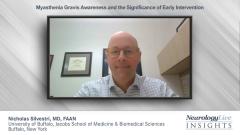
Efgartigimod in Myasthenia Gravis
Nicholas Silvestri, MD, FAAN, discusses neonatal Fc receptor and how it contributes to the pathophysiology of myasthenia gravis, as well as the study design, efficacy, safety, and quality-of-life data with efgartigimod phase 3 ADAPT study.
Nicholas Silvestri, MD, FAAN: Efgartigimod is a fetal neonatal receptor antagonist. It’s an Fc antibody portion that binds to the fetal neonatal receptor, blocking it and reducing the recycling of IgG. It was initially developed for the treatment of generalized myasthenia gravis [gMG]. It showed good results in a phase 2 trial and then subsequently in the phase 3 ADAPT trial with regard to efficacy, tolerability, and safety. It’s being looked at in a few other autoimmune disorders. Specifically, it’s being looked at in a large phase 3 study called the ADHERE trial for the treatment of chronic inflammatory demyelinating polyradiculoneuropathy, or CIDP.
The phase 3 ADAPT trial of efgartigimod looked at patients with generalized myasthenia [gravis]. The vast majority were acetylcholine receptor positive, but a smaller number of patients had MuSK myasthenia [gravis] as well as seronegative myasthenia [gravis]. However, the primary outcome measures used the acetylcholine receptor–positive patient population. The primary outcome measure was looking at the change in MG-ADL [Myasthenia Gravis Activities of Daily Living scale] from baseline to following treatment. MG-ADL is a validated highly used outcome measure in myasthenia gravis trials that looks at activities of daily living that would be affected in patients with myasthenia gravis. The lowest score is 0, being not at all affected; a high score [of 24] is quite affected by myasthenia gravis.
In terms of the primary outcome measure, the study found that patients with acetylcholine receptor–positive disease had a significantly higher percentage of response based on the MG-ADL score after 1 cycle of treatment vs placebo. There was a 68% response rate after 1 cycle of treatment. After 2 cycles of treatment, there was a 78% response rate. That was more prevalent than in placebo. Some of the secondary outcome measures looked at were changes in the quantitative myasthenia gravis score, which is a sophisticated physical examination done by a physician or a health care provider. That was statistically significant in favor of efgartigimod as well. Other measures looking at quality of life were positive in favor of efgartigimod over placebo. Those were the efficacy data. In terms of safety, the major adverse effects that occurred were headache, nasal pharyngitis, and some joint pain with infusions, though those were fairly uncommon. They were more common compared with placebo, but fairly uncommon—10% or 11% for headache, and the rest were in the single digits. But generally speaking, it was safe, well tolerated, and effective in treating patients with gMG.
More recently presented long-term data show that treatment cycle after treatment cycle, the effect is the same. Patients are continuing to benefit after multiple treatment cycles. There have been no new safety signals in patients being treated with the medication for longer periods of time. And the tolerability seems to be fairly durable over time. The extension [study] data look as promising, if not more promising, than the original ADAPT trial.
Subcutaneous efgartigimod is the form of efgartigimod being studied in the ADHERE trial for CIDP. The company is also looking to have subcutaneous efgartigimod approved for treatment of myasthenia gravis, and we should know about that in the coming months.
Transcript edited for clarity.
Newsletter
Keep your finger on the pulse of neurology—subscribe to NeurologyLive for expert interviews, new data, and breakthrough treatment updates.
















